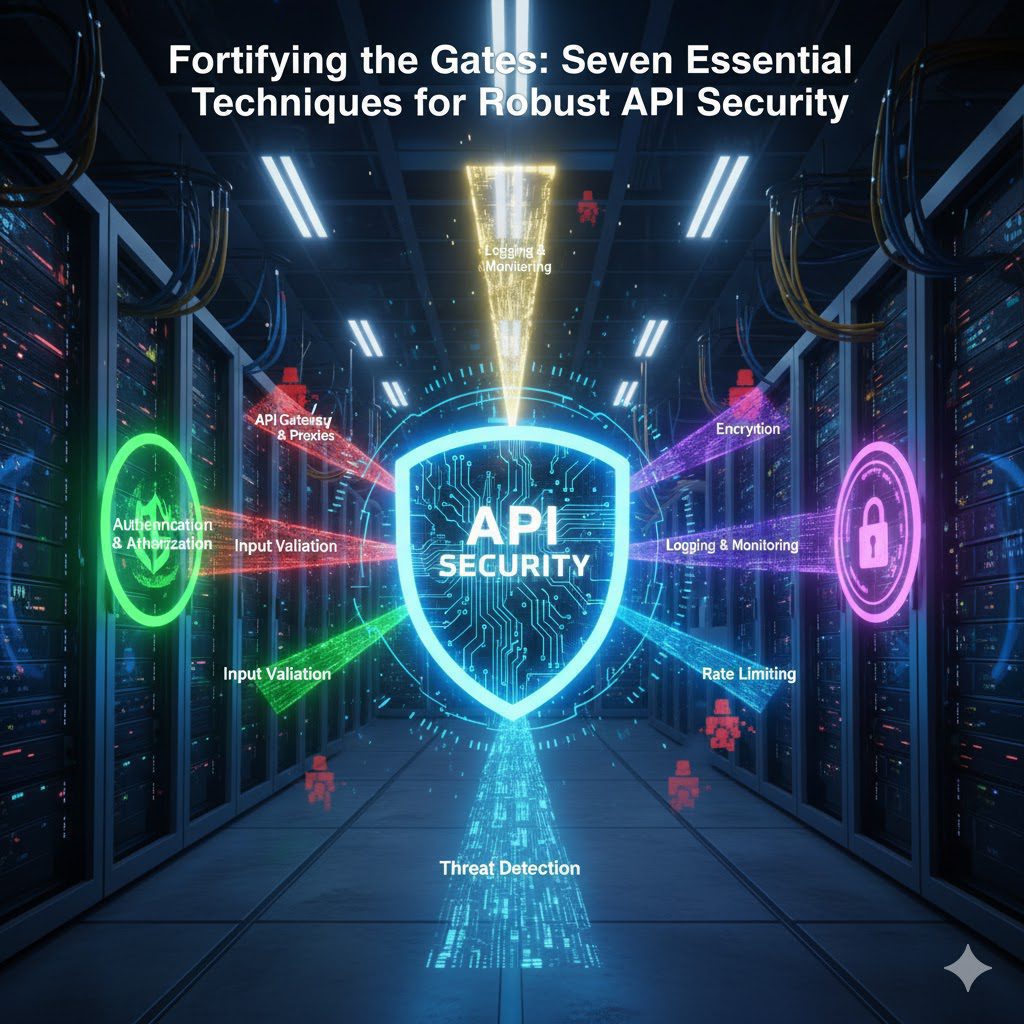In the digital realm, Application Programming Interfaces (APIs) serve as the critical infrastructure for nearly all modern applications, acting as the indispensable communication layer between various software systems. They are, in essence, the sophisticated digital doors through which data and functionality flow into your internal systems. If these “doors” are left unsecured, they become direct, unmonitored entry points for malicious actors to access sensitive user data, disrupt services, and compromise the entire operational integrity of a system.
To safeguard against this constant threat, a multi-layered and rigorous approach to API security is non-negotiable. This article will explore seven proven, high-quality techniques that every organization must implement to protect its APIs from a spectrum of cyberattacks, ensuring the confidentiality, integrity, and availability of its data.
1. Rate Limiting: The Traffic Controller of Your API
Rate limiting is a fundamental technique for API protection, serving as a powerful mechanism to control the volume of requests a client can make to an API within a defined time window. Its purpose is twofold: to ensure service availability and to protect against brute-force attacks.
Mechanism of Control
A practical example illustrates its function: an API may be configured to allow a specific user, identified by a unique identifier, to make a maximum of 100 requests per minute to a particular resource. Should the client attempt to send the 101st request within that minute, the API gateway or server will automatically reject the request, typically returning a status code like 429 Too Many Requests. The client is then temporarily blocked and must wait until the time window resets before sending subsequent requests.
Protection Against Overload and Brute Force
Without properly configured rate limits, a malicious user or attacker can quickly overwhelm the system. By sending thousands of requests per minute, they can create a Denial of Service (DoS) or Distributed Denial of Service (DDoS) condition, consuming server resources and effectively taking the service down for legitimate users. Furthermore, high request volume is a prerequisite for brute force attacks, where an attacker uses automated tools to repeatedly guess credentials or keys until successful.
Implementation Strategies
Effective rate limiting employs granular control, configured at multiple levels:
- Per-Endpoint Limiting: This applies a strict request limit specific to individual API endpoints. For instance, a
/commentsendpoint might have a lower, stricter limit for POST requests (creating a comment) compared to GET requests (fetching comments), reflecting the higher resource consumption and potential for abuse associated with write operations. - Per-User or Per-IP Limiting: This identifies and blocks individual rogue clients. By tracking requests based on a user’s authentication token or their unique IP address, the system can enforce the policy. If a user’s IP address is flagged for over-utilization, their requests are blocked, isolating the threat.
- Overall System Limiting: To protect against sophisticated DDoS attacks where an attacker uses a massive network of compromised machines (bots), each with a different IP address, an overall rate limit is essential. This sets a maximum threshold for the total number of requests the entire API server can handle simultaneously. If the collective inbound traffic exceeds this global limit, all requests may be temporarily throttled or blocked until the root cause of the spike is investigated and mitigated.
2. Cross-Origin Resource Sharing (CORS): Defining Trust Boundaries
Cross-Origin Resource Sharing (CORS) is a browser security mechanism that dictates which web domains are permitted to interact with your API from a user’s browser. It is a critical defense against attacks that exploit the trust relationship between a user’s browser and your API.
The Need for Origin Control
The foundation of the CORS policy is the “same-origin” principle, a security concept designed to prevent scripts running on one website from accessing resources on another website. Without proper CORS configuration, a malicious website could leverage the victim’s browser to send unauthorized requests to your API.
To protect resources, an API should be explicitly configured to define its allowed origins. If your API is intended solely to serve your official front-end application, hosted at https://app.yourdomain.com, then only requests originating from this specific domain should be permitted.
Blocking Malicious Requests
When a user visits a malicious website (e.g., https://anotherdomain.com), and that site attempts to make an AJAX request to your API, the browser will first check the API’s CORS policy. If https://anotherdomain.com is not in the list of allowed origins, the browser will block the request from ever reaching the API, preventing unauthorized data access or malicious operations on the user’s behalf. This is especially vital for APIs that handle authentication or sensitive data, ensuring that only trusted front-end applications can initiate interactions.
3. Defense Against Injection Attacks: Parameterized Queries
Injection attacks, particularly SQL Injection (SQLi) and NoSQL Injection, are among the oldest and most dangerous vulnerabilities in web application and API security. They occur when an attacker introduces malicious code or database commands into application input fields, which are then improperly incorporated into a database query.
The Injection Danger
Consider a scenario where user input is directly concatenated into a query string to fetch a record. An attacker could modify the input to include syntactically valid database commands, such as:
$$\text{User Input} = \text{‘ OR 1=1 –}$$
If this input is not properly sanitized or handled, it can alter the query’s logic. The malicious input may bypass authentication checks, allowing the attacker to read, modify, or even delete entire tables and user data from the database. A common exploit includes the use of comments (e.g., -- in SQL) to nullify the rest of the original query, allowing the attacker to execute their injected commands.
The Essential Solution: Parameterization
The definitive defense against all forms of injection attacks is the use of parameterized queries (also known as prepared statements) or Object-Relational Mappers (ORM safeguards).
Parameterized queries separate the SQL command structure from the user-provided data. The query template is pre-compiled by the database, and the user input is then passed to the database as data, never as executable code. The database engine treats the input as a literal value, regardless of whether it contains SQL keywords or commands, thus rendering any injection attempt harmless. ORMs abstract this process, providing a higher-level, secure interface that automatically implements parameterization for all generated queries.
4. Web Application Firewalls (WAFs): The Intelligent Gatekeeper
A Web Application Firewall (WAF) acts as a dedicated security proxy positioned between the public internet and your API endpoints. It is specifically designed to inspect the content of HTTP traffic and filter out malicious requests before they ever reach the application server.
Filtering Malicious Traffic
A WAF operates by utilizing a set of predefined rules and sophisticated detection logic to identify patterns indicative of a cyberattack. For example, a WAF service, such as the AWS Web Application Firewall (WAF) or others, can:
- Block Known Attack Patterns: It can instantaneously block requests containing suspicious SQL keywords, common cross-site scripting (XSS) payloads, or strange, non-standard HTTP methods that suggest a reconnaissance or attack attempt.
- Mitigate Common OWASP Top 10 Threats: WAFs are highly effective at providing a first layer of defense against threats like injection, cross-site scripting, and security misconfigurations.
- Custom Rule Implementation: Beyond standard rulesets, organizations can customize WAF rules to block traffic from specific geographical regions, block known malicious IP addresses, or enforce stringent rules on critical endpoints.
By acting as a “gatekeeper,” the WAF allows normal, valid traffic to pass through to the API while systematically identifying and blocking suspicious requests, significantly reducing the attack surface.
5. Virtual Private Networks (VPNs): Securing Internal APIs
While many APIs are designed to be public-facing, accepting requests from any user on the internet, certain critical APIs should never be exposed to the public internet. These are typically APIs that support internal business operations or administrative tools. For these, Virtual Private Networks (VPNs) are an essential security control.
Creating a Secure Perimeter
A VPN creates a secure, encrypted tunnel over the public internet, effectively extending a private network to remote users. When an API is placed within a VPN-protected network or is configured to only accept connections from a specific, private network, access is inherently restricted.
- Blocking External Access: If a standard web user from the public internet attempts to access this private API, the request will be blocked immediately because the user is not authenticated and connected through the required VPN network.
- Enabling Authorized Access: Conversely, a company employee connected to the corporate VPN can securely make a request to the internal API. Their connection is verified as originating from the trusted network perimeter, allowing the request to bypass the public block and reach the API.
This setup is crucial for protecting assets like the API for an internal admin dashboard, a billing system backend, or any tool that should only be accessible by authorized, verified employees. By isolating internal APIs, the organization eliminates a massive vector for external attack.
6. Cross-Site Request Forgery (CSRF) Tokens: Preventing Unwanted Actions
Cross-Site Request Forgery (CSRF) is a subtle yet dangerous attack that tricks a user’s browser into submitting an unintended request to an application where the user is currently authenticated. This attack relies on the browser automatically including session cookies or other credentials with a request to a site it believes the user authorized.
The Forgery Threat
Consider a user logged into their online banking system, which uses a session cookie for authentication. The user then navigates to a malicious, unrelated website. This malicious site embeds a hidden HTML form or script that automatically sends a request (e.g., to transfer money) to the bank’s API. Because the user is logged into the bank in the same browser, the browser automatically attaches the valid session cookie, and the bank’s API, seeing a legitimate cookie, executes the malicious request.
The Dual Defense Strategy
To prevent CSRF, the defense mechanism must involve two factors:
- Session Cookie: Used to verify the user is logged in.
- CSRF Token: A unique, secret, and unpredictable value generated by the server and included with every state-changing request (e.g., POST, PUT, DELETE).
The server checks that the submitted session cookie is valid and that the CSRF token provided in the request body, header, or URL parameter matches the token the server expects for that user’s session. Since the malicious site cannot access the server’s unique, per-session CSRF token, the unauthorized request fails the validation check and is blocked, while legitimate requests from the bank’s own user interface are allowed to proceed.
7. Input Validation and Sanitization Against Cross-Site Scripting (XSS)
Cross-Site Scripting (XSS) is an injection vulnerability that allows an attacker to inject malicious client-side scripts (typically JavaScript) into web pages viewed by other users. This attack often targets the API by injecting the malicious payload into data intended for storage.
The Script Injection Flow
A common attack vector involves a public forum or comment section:
- Injection: An attacker posts a comment that contains a malicious
<script>tag instead of normal text (e.g., a script designed to steal other users’ cookies). - API Storage: The comment is submitted to the API, which, lacking proper validation, accepts the script and stores it in the database.
- Execution: When another user loads the comment section, the API fetches the data, and the malicious script is rendered by the user’s browser. The browser executes the script, potentially leading to session hijacking (via stolen cookies), unauthorized data modification, or redirection to phishing sites.
Preventative Measures
The most effective defense is to treat all user input as inherently untrustworthy and to enforce strict rules for data format and content before it is stored or displayed:
- Input Validation: At the API level, rigorously validate that the data conforms to the expected type, length, and format. For instance, a comment field should only accept text characters, rejecting HTML tags or scripts.
- Output Sanitization/Encoding: Before rendering any user-provided data back to a web page, the server must sanitize or encode it. This process converts potentially malicious characters (like
<and>) into harmless, equivalent entities (<and>). This ensures that the browser interprets the input as mere text to be displayed, not as executable code.
Robust input validation on the API side prevents the payload from ever reaching the database, while proper output encoding on the front-end ensures that any residual malicious content is defused before execution.
Conclusion: A Multi-Layered Security Mandate
The security of APIs is synonymous with the security of the entire modern enterprise. As the primary communication conduit for applications, APIs are constantly probed and targeted by a diverse and sophisticated range of threats. Relying on a single security measure is insufficient; a robust defense requires a layered strategy that addresses vulnerabilities at every stage of the API lifecycle.
By diligently implementing these seven proven techniques—enforcing rate limiting to prevent overloads and brute force, defining clear trust boundaries with CORS, eradicating injection vulnerabilities through parameterized queries, deploying an intelligent WAF for perimeter defense, isolating internal services with VPNs, mitigating session hijacking with CSRF tokens, and ensuring data safety through rigorous XSS prevention—organizations can transform their digital “doors” into fortresses. This commitment to comprehensive, multi-layered API security is the clearest path to operational resilience and the non-negotiable requirement for protecting user trust and critical business assets in the digital economy.






